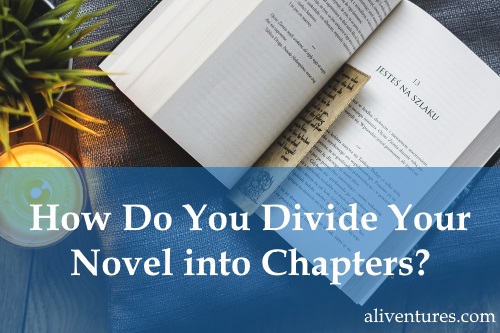How Do You Divide Your Novel into Chapters?

This post was inspired by an email conversation with Emma from the brilliant blog Science at Your Doorstep and by a question from an Aliventures reader. It was first published in April 2018 and updated in October 2021.
Pick up the nearest book. Whether it’s fiction or non-fiction, it’s almost certainly split into chapters.
As readers, we take that for granted. Chapters give us an easy way to discuss where we’ve got to in a new book (“I’m on Chapter 10 now…”) – and provide handy stopping points in the text where we can put the book down.
As writers, though, chapters can be surprisingly tricky.
How many should you have? How long should they be? Do you even need chapters at all?
Chapters, Parts, or … Nothing?
If you’re writing a novel or novella, you’ve got a fair few options for how you divide your text into pieces. You could have:
- A single volume divided into chapters (probably around 10 – 40, depending on the length and genre).
- A single volume divided into parts and chapters (normally 2 – 5 parts, though this could be higher for a long book).
- A single volume with no chapters or any other divisions at all.
- Serialised chapters, parts, or even “books”, published sequentially.
Option #1 is standard, ordinary, and familiar to all readers. Whatever genre you’re writing in, dividing your work into chapters is highly unlikely to be surprising or controversial.
Option #2 is fairly ordinary, though more common in certain genres (literary, historical, some types of speculative fiction).
Option #3 is unusual and tends to be a self-consciously literary option. That doesn’t mean there’s anything wrong with it, but it’s not likely to be a great approach if you’re writing in a commercial genre where readers expect chapters.
Option #4 was common in the early life of the novel (Dickens was serialised, mainly in stand-alone monthly parts; my favourite 18th century novel, Samuel Richardson’s Clarissa, is absolutely massive and was originally published in seven volumes between 1747-48 at different times).
But today, with, digital publishing, we’re seeing a resurgence in this type of serialised novel-length work: some ebooks are published as short “episodes” that are then collated into “box sets”, and fanfiction – on major archives, at least – tends to be published in “chapters”, though these may be tens of thousands of words long.
If you’re unsure what you should go for, I’d suggest looking at books in your genre. (If you’re writing cross-genre or something that isn’t easily pigeon-holed, find books that are at least vaguely similar.) See what they do.
Do Your Chapters Need to Be the Same Length?
I’m going to tackle this before we look at the question of where to end your chapters, because it tends to worry authors unnecessarily.
Your chapters do not need to all be the same length.
You can have one chapter of 2,000 words and another of 5,000 words. There’s no rule against it, and readers may not even notice, let alone mind.
What I would suggest is having a roughly “standard” chapter length in mind (mine tend to be around 1,500 – 2,000 words); if a chapter is significantly shorter or longer than standard, you might want to double-check that the pacing doesn’t feel off.
You’ll normally want to avoid a dramatic and sudden variation in chapter lengths (e.g. 500 words followed by 6,000 words).
Generally, though, writers worry far more about consistent chapter lengths than readers ever will! What matters is that you tell your story at the right pace and in the right way. I’ve never, in years of reading books, discussing books and reading reviews, seen a reader complain that one chapter was only 5 pages and the next was 10.
Where Should You End a Chapter?
It’s entirely up to you!
As K.M. Weiland points out, a scene is a crucial structural unit – but a chapter can end (pretty much) wherever you want.
Here are a few things to think about:
- Some writers will say you should always end chapters on a cliffhanger: I think this can feel a bit artificial, though it’s standard in certain genres (thrillers, crime, adventure, etc). If you go with this approach, remember that quite small things can still “hook” readers into the next chapter; characters don’t need to be in life-or-death peril!
- Other authors (me included) like to end chapters when they switch points of view. That doesn’t rule out ending on a cliffhanger, of course – but it does tend to mean that chapter breaks come at natural pausing points or changing points within the text.
- If there’s a large gap of time in your novel, then it often makes sense to have a chapter break to “jump” the missing time.g. chapter 10 might end on October 31st and Chapter 11 begins on January 1st.
If a chapter feels like it’s dragging on and on, then your problem might be with the narrative itself rather than your division of it. Maybe you’re giving too much detail (and it would be better just to end the chapter at a high point and leave the rest to our imagination), or maybe something needs tweaking slightly in the plot.
When I’m drafting, I tend to simply end chapters wherever it feels natural to do so. In the redraft, I often end up trimming and combining chapters (particularly early in the novel) that didn’t quite work – the important thing during the draft is just to keep moving forward.
How Should You Name Chapters?
Some books start each chapter with “Chapter 1”, “Chapter 2”, etc.
Others have “1”, “2”, etc.
Others have a symbol or a character’s name, if the novel alternates between two different points of view.
Some (particularly children’s books and humourous fantasy) have titles for each chapter – e.g. the first chapter of Harry Potter is titled “The Boy Who Lived”.
Whatever option you go for, be consistent. You might have an occasional chapter that’s named differently (“Prologue” and “Epilogue” are the obvious ones; I’ve also seen – and used – “Interlude” in the middle of a novel).
When you edit, make sure you haven’t missed off a chapter number altogether, repeated a number, or skipped a number. This tends to happen to me when I’m shifting material around a lot as I redraft – thankfully my editor is great at picking up on it.
How Many Chapters Should You Have?
The number of chapters you have is, obviously, going to depend on the length of your chapters. If you want short chapters, you’re going to end up having quite a lot of them.
There’s no right or wrong answer when it comes to the number of chapters in your book. I’d recommend looking at other similar books (the same genre of fiction, or the same type of non-fiction) to see how many chapters they tend to have.
You don’t need to go out and buy or borrow a lot of books to do this: just use Amazon’s “look inside” feature, which will normally show the list of chapters for a book. You can also get a free sample of the book if it’s available on Kindle.
In general, full length novels will normally have somewhere between 10 and 40 chapters, but they can have far more. Richard Osman’s recent hit The Thursday Murder Club had 115 chapters, many of them quite short.
Ultimately, the number of chapters you have doesn’t really matter: what’s important is that you use chapter divisions effectively in your book, whether it’s fiction or non-fiction.
Want some help with issues like viewpoint and novel structure?
Check out my self-study packs, particularly the Advanced Fiction Pack (#5) and the Novel Editing Pack (#6).
Each pack costs just $20 and includes four full seminars (audio or video) plus nicely edited transcripts. You also get a worksheet summarising each seminar.
You can also get all six self-study packs for just $50. Find out about all of them here.
About

I’m Ali Luke, and I live in Leeds in the UK with my husband and two children.
Aliventures is where I help you master the art, craft and business of writing.
Start Here
If you're new, welcome! These posts are good ones to start with:
Can You Call Yourself a “Writer” if You’re Not Currently Writing?
The Three Stages of Editing (and Nine Handy Do-it-Yourself Tips)
My Novels

My contemporary fantasy trilogy is available from Amazon. The books follow on from one another, so read Lycopolis first.
You can buy them all from Amazon, or read them FREE in Kindle Unlimited.


Excellent post, Ali.
Without chapters, it would be hard to structure a novel. Sometimes we need to give readers space to catch their breath.
I am a fan of ending chapters in a cliffhanger, even if just a small revelation or question.
Also, when plotting a novel, having chapters in mind makes it easier to visualize the storyline.
I do struggle with finding the right lenght. I guess it is a matter of personal preference.
I seem to prefer shorter chapters to longer ones myself.
Is there a rule against naming chapters? Modern writers hardly ever do it unless, as you say, they switch points of view characters back and forth.
You should write a follow up about book parts. One of the best novels I’d read last year, Mur Lafferty’s Six Wakes, divides the novel into six parts, one for each ‘wake’ and it works without feeling gimmicky.
Thanks Ingmar! I like shorter chapters too, probably because I write quite fast-paced novels (I don’t mind long chapters when I’m reading).
I don’t think there’s any rule against naming chapters, but it does tend to be something associated with children’s books. I suppose it also adds an extra layer of hassle for the writer (I have enough trouble coming up with a title for a whole book, let alone one for each chapter).
I’ll have to check out Six Wakes — I used to listen to Mur’s “I Should Be Writing” podcast way back (more than a decade ago!) and always found her very informative and entertaining.
I always try to leave them wanting to find out what happens next. Not necessarily a traditional cliffhanger every time, but just something they need to find out next. Great article! Keep up the good work.
Talk soon
Cary
Thanks Cary! That sounds like a good approach.
very nice post dear
Hi Ali,
What a great article! I am working on my book, and I was looking for a resource that will help me divide my content into chapters. Your article was very informational and gave me ideas on how I want my book to be divided. Thanks for sharing multiple options via your article. I think I will be dividing my book into parts, I suppose it will be easier to distinguish, and I won’t have to go through the process of dividing my book into several chapters.
Thanks, John, really glad this was helpful! And best of luck with your book. 🙂